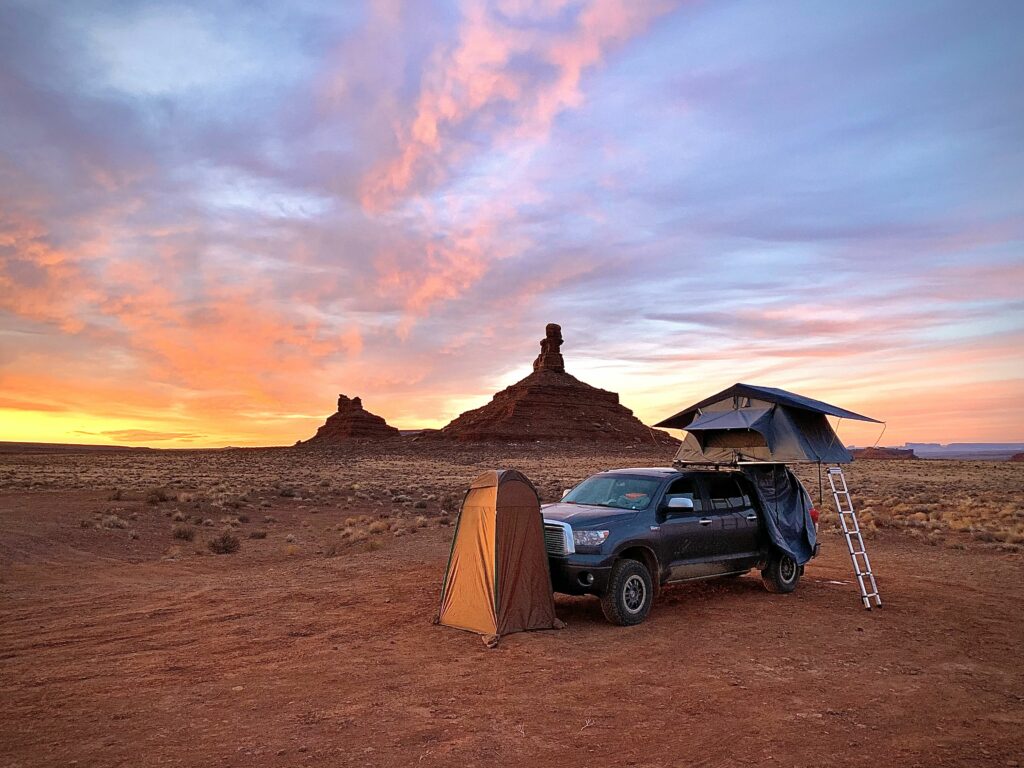Trying to decide between a Roof Top Tent and a Camper Shell for your truck camping expeditions? Well, you’re in the right place.
As an owner of a truck with a camper shell and a RTT, I have slept in all configurations and have some good thoughts on this topic that will hopefully help you put in your next camping sleep setup!

Camping season is once again here and the gear purchases are in full swing. A major purchase decision for all campers is the sleeping setup. Traditionally, people buy a tent or RV for sleeping when camping.
However, with the exploding popularity of overlanding and vanlife, many people look to make their adventure overlanding and camping vehicle a single point of self-sufficiency, which includes the bedding and tent options.
Personally, I have done it all, I spent years on a ground tent, then got a camper shell for my 2013 Toyota Tundra and started sleeping in that.
While I love truck camping (and you should start, here’s why), truck bed camping has some limitations we will address below.
The next move up is to get a roof top tent, and that as well as its own set of considerations to take in before buying either one.
So, I’ll shut up and start giving the benefits and downfalls of each to better help you make that big money decision.
Benefits and Downsides When Choosing a RTT vs A Camper Shell
Traditionally, pickup truck owners who wanted to keep their gear, their dogs and their tools out of the elements, looked to add a camper shell to the bed of the truck.
This allowed for gear and animals to stay in the back, but also keep them enclosed out of the elements and more protected.
However, as the truck camping scene exploded, people are now sleeping in the back of their pickup inside the camper shell more and more. Here are some benefits and downsides to sleeping in a camper shell.
Quick ground rule, since the camper shell and roof top tents are basically priced the same ($1500-$3000) we won’t make price a deciding factor.
You can go with basic or fancy with each, and you will still have spent about the same.
Benefits of Camper Shell Camping
- No Need for a Ground Tent: Your Camper Shell Is Built Right Into Your Truck
- No Need to Assemble: With a Camper Shell, its ready all the time, no setup, no tent poles and nothing left to do but open the door, get in and sleep.
- More Sturdy Against The Elements: A camper shell is traditionally fiberglass framed and because of this, has a much better time with high winds, rain, snow and even hail. You can sleep sound knowing the elements won’t touch you.
- Easy To Mount Long-Term Lighting: A Camper shell is fixed in place, which means whatever organization options you build and install (like drawers and Lighting) stays in place at all times. Conversely, a roof top tent has to be opened/closed and collapsed for storage so most all items must be removed when the tent is closed.
- Doubles as non-camping storage when not camping, it can hold the pets, gear, lumber and whatever else when you need it, unlike a RTT which is only for sleeping.
- Looks Better: Seems silly, but let’s be honest, while a RTT is a visual badge of honor to flex on other campers, it’s not the prettiest thing otherwise. Conversely, a nice camper shell is color-matched to your truck and it also matches the styles and lines of your truck.
- Wired Power: You can run AUX power wires to your bed of the truck and run lights, charge a phone or whatever you need.
Downsides of a Camper Shell over a Roof Top Tent
- Truck Bed Length: The majority of full-sized truck beds are between 5.5ft and 5.7ft, the average guy is over that height, so in most cases, you will be bending your knees all night and feel a bit cramped in the morning.
- Bedding: Unless you build a sleeping platform with mattress toppers or some other comfort material, you will have the additional costs of a good sleeping pad to keep you from waking up with a stiff back from the metal truck bed.
- Room: While this may not seem so obvious, there is a lot less room due to the fact that your pickup bed has the wheel wells on the interior of your bed, it creates a choke point and ultimately less room for sleeping.
- Gear Placement: When sleeping in your truck bed, you are now in a position where you need to move your gear from the bed of the truck to inside of the cab (or leave it outside) while you sleep. Depending on if you live in bear country, you need to get that cooler and waste inside at night.
So, as you can see there are some definite downsides (and benefits) to a camper shell for camping. Again, prices are pretty comparable, so this is just the lifestyle and logistic concerns.
However, with all of that said, let’s take a look below at the benefits and downsides of a roof top tent.
BTW: If you are new to tent camping altogether, our friends over at Campgrasp.com put together an excellent resource with the article Tent Camping 101: Tips For Beginners and it’s definitely worth your time.
Benefits of Roof Top Tent Camping
- All-in-one Design: With a RTT, it is designed to be all ready to go when you want to sleep, just like a camper shell, the tent is ready to go and only takes about 1-3 minutes to set up.
- Built-in Bedding: On a RTT, the mattress comes with the roof top tent and its generally a nice, 3-5 inch thick mattress, making for a nice night of sleep without any modifications, right out of the box.
- Gear Placement: Since you are sleeping in a RTT, there is no need to move your gear anywhere special due to your sleeping locations. Keep gear in the truck bed and sleep in the RTT without any adjustments.
- Modular Windows: RTT’s have lots of windows and “skylights” on all sides and the roof, this gives you the ability to have lots of venting and stargazing opportunities. On a camper shell, there are generally only two side wall windows.
- Still Feels Like Tent Camping: You’re still sleeping in a tent, you still get to hear the sounds at night, feel a breeze, etc.
- More Room Than The Camper Shell: Because you get a fold-out design with no wheel well interference, that means you have a LOT more sleeping area than in the bed of your truck. This means for those of you over 6ft, you can still sleep stretched out, and depending on the model, still have room for your spouse, kids, dog, etc.
Downsides of a Roof Top Tent Camping Over A Camper Shell
- It Requires A Roof Rack: RTT’s must be mounted to a roof rack, and not the factory roof rack. Roof Top Tents require aftermarket roof racks (for the most part) and thats another $500+ expense for the rack, bases, and crossbars.
- It’s Always There: Because it is mounted to your roof rack, it’s pretty much staying on your vehicle even when you are not camping. This includes not really being able to go through car washes or low entry parking garages.
- Not As Sturdy: Yes, it got internal support frames, but in reality, your RTT is still susceptible to bad weather and winds. A tree branch could fall, hail could move in and extreme temps will make the RTT a bit less comfortable (and potentially dangerous) in inclement weather situations.
- Easier to Damage: It’s a tent, which means it’s easier to tear, break or damage your tent over a solid camper shell.
- No ability to hardwire any electronics into the sleeping area without a Jackery or other portable inverter inside the tent or running power wires inside the tent.
Roof Top Tent vs Camper Shell: Which Is Better?
As you can see, there are many pros and cons to consider when choosing between a RTT and a camper shell. It’s not really a budget issue as they both run around $2000 on average.
It comes down to more personal preference. However, take in the following considerations when making that final thought on your purchase:
- Are you a lone traveler? If so, a camper shell is likely fine, but a family will need a RTT, not a camper shell.
- How Often Do You Camp? If you camp once a year, a RTT doesn’t make sense, after all, it’s permanently stuck to your roof (kind of) and on the other hand, at least a camper shell has other uses.
- How Tall Are You? If you are over 5.7ft, you likely will want a RTT so you can sleep comfortably.
- How much gear do you bring? If you bring a ton of gear, you may want the RTT, this allows you to keep gear storage separate from sleeping areas.
With all of that said, a roof top tent is the better choice for active outdoorsy types over a camper shell as it’s very good at being an elevated sleeping spot that doesn’t interfere with other gear.
A RTT offers more room, more comfort and more ventilation options.
What Did We Pick?
I was in the same boat you were, I didn’t know which to buy. So, I started by buying the camper shell and spent MANY nights sleeping in it with the wife and dog. I built a sleeping platform (see video below) and drawers for gear.
However, the limited sleeping space, leg room was a bummer for me at 6ft. Also, we have kids, so that meant either kids slept on the bench seat in the cab of the truck or we set up a separate tent for them which was a pain too.
I then purchased a Roof Top Tent and mounted it on top of the existing camper shell. This turned out to be a great option.
It has all the room we need for 4 people. Plus, if the kids want, they can sleep in the camper shell and mom and dad can sleep in the RTT (or vice versa).
Having the combo of the RTT mounted on top of a camper shell has turned out the best option for us. Plus the kids love climbing the ladder up into the tent, it’s just more fun for them.
Final Word
In my opinion, for active folks who camp more than a few nights out of the year, a roof top tent gets the win over a camper shell.
Size, space, gear storage, and comfort all out-do the camper shell. However, if you dont camp more than a couple times out of the year, a camper shell has a more dual-purpose and can be used the remainder of the year as more camper shells are for non-camping applications.
Hopefully this was helpful in your decision making. If you’re new to truck camping and want to learn more, I put together a very detailed Guide To Truck Camping that you should definitely check out. We’ll see you out on the trail!
